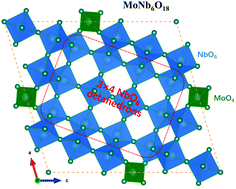Shear-structured MoNb6O18 as a new anode for lithium-ion batteries†
Abstract
Owing to their high theoretical capacities, safe operational voltage, unique tunnel-shaped structural features for fast lithium ion transfer, and structural stability, niobium-based oxides are regarded as promising candidate anode materials for lithium-ion batteries (LIBs). Here, molybdenum niobium oxide (MoNb6O18) with a high theoretical capacity of 399 mA h g−1 (Mo6+/Mo4+ and Nb5+/Nb3+) was developed as a new anode material for LIBs. The crystal structure of MoNb6O18 was observed to display a Wadsley–Roth phase of the ReO3 shear structure. The discharge capacity of micron-sized particles of MoNb6O18 was measured to be 219.4 mA h g−1 with a high initial Coulombic efficiency of 96.8% at 0.2C and 154.3 mA h g−1 at 1C from 1.0 to 3.0 V. The results of ex situ X-ray diffraction (XRD) experiments revealed the ability of MoNb6O18 to serve as an intercalation-type anode material for lithium ion storage with outstanding structural stability. Also, an LiMn2O4//MoNb6O18 full cell displayed desirable lithium-ion storage properties.



 Please wait while we load your content...
Please wait while we load your content...